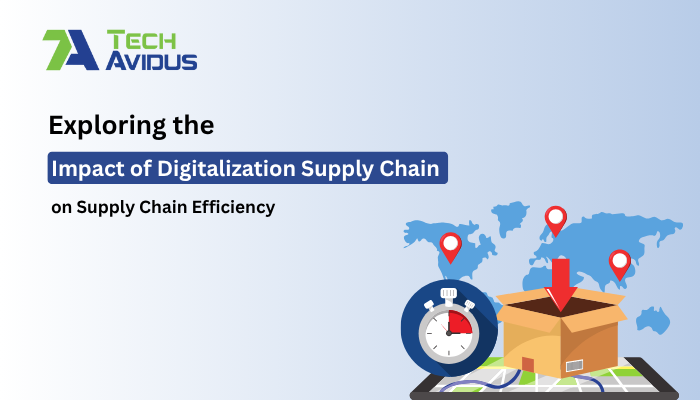
In today’s fast-moving, tech-driven global economy, supply chain and logistics professionals face increasing pressure to deliver faster, optimize costs, and minimize risks. The traditional supply chain model, often manual and siloed, is no longer equipped to meet these challenges effectively.
This is where digitalization of the supply chain steps in.
With technologies like IoT, AI, cloud computing, and big data analytics, businesses are embracing supply chain digital transformation to stay ahead of the curve. But how exactly does this transformation impact efficiency, and what should you consider while making the shift?
Digitalization of the supply chain refers to the integration of digital technologies into every aspect of the supply chain lifecycle—from procurement and production to logistics and customer service.
Instead of operating in disconnected silos with spreadsheets, paper trails, and phone calls, a digitalized supply chain uses real-time data, intelligent systems, and connected tools to enable smarter decisions, agility, and transparency.
Key Technologies Driving Digitalization:
• IoT sensors for real-time tracking
• Artificial Intelligence (AI) for demand forecasting
• Blockchain for traceability and fraud prevention
• ERP integration for seamless operations
• Cloud-based platforms for data access and collaboration
This entire approach is also known as electronic supply chain management, where the physical supply chain is complemented and enhanced through digital workflows.
Before we understand how digitalization helps, let’s look at the limitations of legacy systems.
Why is my supply chain inefficient?
Supply chains become inefficient due to:
• Lack of real-time visibility
• Manual processes are prone to errors
• Disjointed systems and poor communication
• Slow response to market demand or disruptions
Problems in traditional supply chain systems:
• Data silos: Procurement, inventory, and logistics operate on different platforms.
• Delayed decision-making: Due to outdated or unavailable data.
• Limited scalability: Manual systems don’t scale efficiently with growth.
• High operational costs: Due to excess inventory, redundant processes, and delays.
Manual systems are often reactive rather than proactive. They make it difficult to:
• Predict demand accurately
• Track goods in real-time
• Identify supply chain bottlenecks quickly
• Collaborate across partners
Digitalization transforms supply chain performance across multiple levels:
1. Improved Visibility and Transparency
Real-time tracking using IoT and RFID helps companies monitor shipments, predict delays, and improve ETAs. For instance, Maersk uses IoT and blockchain to offer end-to-end container visibility, reducing theft and misrouting.
2. Enhanced Decision-Making with Data
AI-powered tools analyze historical data to forecast demand, optimize routes, and reduce waste. According to McKinsey, companies using AI in their supply chains can reduce logistics costs by 15% and inventory levels by 35%.
3. ERP Integration with Supply Chain Systems
Integration of ERP with supply chain systems ensures that procurement, production, and distribution communicate effectively. This leads to:
• Automated order processing
• Reduced errors in inventory
• Streamlined warehouse management

4. Operational Efficiency and Automation
Robotics and RPA automate repetitive tasks like sorting, labeling, and invoice processing. Amazon’s fulfillment centers, for example, use robotic systems to process thousands of orders per hour.
5. Better Risk Management
Advanced analytics tools can predict potential disruptions—from supplier issues to geopolitical risks—allowing proactive mitigation strategies.
6. KPI Improvements from Supply Chain Digitalization
Some key performance indicators (KPIs) that improve with digitalization:
• Order accuracy
• Inventory turnover rate
• Lead time reduction
• On-time delivery rate
Real-world applications of digitalization supply chain in logistics include:
• DHL's Smart Warehouse: Uses robotics, AI, and AR glasses for improved picking accuracy and speed.
• FedEx SenseAware: Tracks package temperature, humidity, and location in real-time.
• Flipkart's Digital SCM: Optimized delivery timelines using route planning algorithms and real-time updates.
Here’s what lies ahead:
1. AI + Human Collaboration
Humans and AI working side-by-side for predictive insights and automated execution.
2. Sustainable Supply Chains
Using data to reduce emissions, minimize waste, and promote ethical sourcing.
3. Hyper-Automation
Combining AI, RPA, and machine learning to automate end-to-end workflows.
4. Decentralized Networks
Blockchain and smart contracts enable trustless, decentralized supply ecosystems.
The digitalization supply chain revolution is not just about technology—it's about rethinking how supply chains operate to achieve greater efficiency, agility, and customer satisfaction.
By embracing supply chain digital transformation, companies can:
• Overcome legacy inefficiencies
• Automate and optimize operations
• Make smarter decisions using real-time data
Ready to explore digital transformation in your supply chain? Get a Free Consultation now.
Q1: Why is my supply chain inefficient?
A: Most inefficiencies stem from manual processes, poor visibility, and lack of data-driven decision-making.
Q2: What are the problems in traditional supply chain systems?
A: Common problems include data silos, delayed responses, inaccurate forecasting, and high operational costs.
Q3: How does digital transformation affect supply chains?
A: It improves visibility, reduces costs, enhances agility, and enables proactive decision-making using real-time data.
Q4: What is electronic supply chain management?
A: It refers to managing supply chain operations digitally using tools like ERP, AI, and cloud software for real-time collaboration and automation.
Q5: What are the benefits of supply chain automation?
A: Automation reduces errors, speeds up processes, lowers costs, and increases scalability.
Q6: What are some digitalization use cases in logistics?
A: Examples include IoT-based shipment tracking, AI-driven route optimization, and smart warehouses.
Q7: How can technology improve supply chain efficiency?
A: By automating workflows, integrating systems, forecasting demand accurately, and optimizing inventory and logistics.
Q8: What KPIs improve with supply chain digitalization?
A: On-time delivery, order accuracy, inventory turnover, and operational cost per unit.

Keshu Keshvala is the Chief Marketing Officer at TechAvidus — a trusted software development company based in India, specializing in AI-powered web, mobile, and custom software solutions. With 10+ years of experience in the IT and software development industry, Keshu has played a key role in delivering enterprise-grade digital solutions that help clients reduce costs, improve efficiency, and achieve optimal results tailored to their business needs.
Our Top 1% Tech Talent integrates cutting-edge AI technologies to craft intelligent, scalable, and future-ready solutions.
All Rights Reserved. Copyright © 2025 | TechAvidus